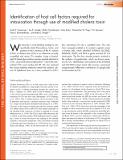Identification of host cell factors required for intoxication through use of modified cholera toxin
Author(s)
Guimaraes, Carla P.; Carette, Jan E.; Varadarajan, Malini; Antos, John; Spooner, Eric; Brummelkamp, Thijn R.; Ploegh, Hidde; Popp, Maximilian W.L.; ... Show more Show less
DownloadGuimaraes-2011-Identification of ho.pdf (2.948Mb)
PUBLISHER_CC
Publisher with Creative Commons License
Creative Commons Attribution
Terms of use
Metadata
Show full item recordAbstract
We describe a novel labeling strategy to site-specifically attach fluorophores, biotin, and proteins to the C terminus of the A1 subunit (CTA1) of cholera toxin (CTx) in an otherwise correctly assembled and active CTx complex. Using a biotinylated N-linked glycosylation reporter peptide attached to CTA1, we provide direct evidence that ∼12% of the internalized CTA1 pool reaches the ER. We also explored the sortase labeling method to attach the catalytic subunit of diphtheria toxin as a toxic warhead to CTA1, thus converting CTx into a cytolethal toxin. This new toxin conjugate enabled us to conduct a genetic screen in human cells, which identified ST3GAL5, SLC35A2, B3GALT4, UGCG, and ELF4 as genes essential for CTx intoxication. The first four encode proteins involved in the synthesis of gangliosides, which are known receptors for CTx. Identification and isolation of the ST3GAL5 and SLC35A2 mutant clonal cells uncover a previously unappreciated differential contribution of gangliosides to intoxication by CTx.
Date issued
2011-10Department
Massachusetts Institute of Technology. Department of Biology; Whitehead Institute for Biomedical ResearchJournal
Journal of Cell Biology
Publisher
Rockefeller University Press
Citation
Guimaraes, C. P. et al. “Identification of Host Cell Factors Required for Intoxication Through Use of Modified Cholera Toxin.” The Journal of Cell Biology 195.5 (2011): 751–764. Web.
Version: Final published version
ISSN
0021-9525
1540-8140